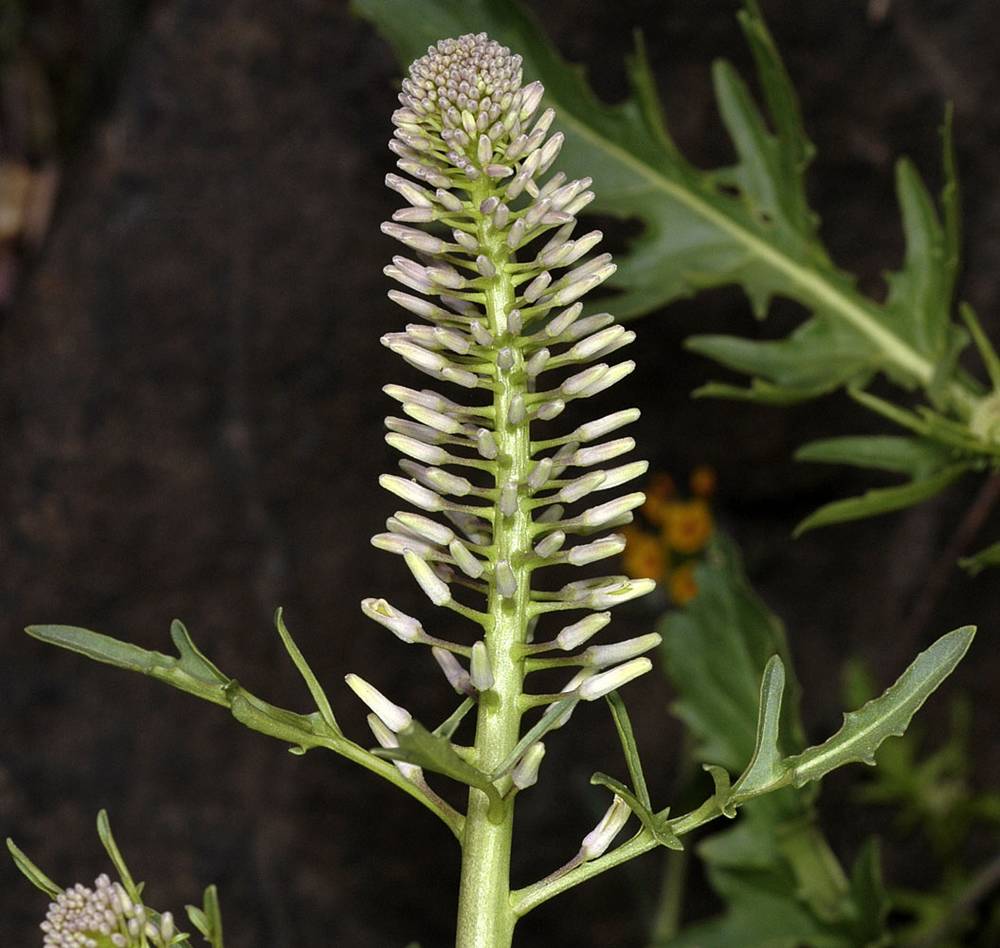Thelypodium laciniatum
Thelypodium
cutleaf thelypody, thick-leaved thelypody, western thelypodium
thelypody
solid; (1.3)2.6–10(14.5) dm.
(4.3)6.8–24(45) × (1)1.8–8.5(14) cm;
margins pinnately lobed or laciniate, glabrous;
petioles (1)1.5–10(15) cm.
rosulate or not;
margins entire, dentate, laciniate, lyrate, or pinnately lobed, petiolate.
lower similar to basal; middle and upper not auriculate;
margins entire, sinuate, or laciniate, petiolate.
bases auriculate to sagittate or not, petiolate or sessile.
densely flowered, fruiting pedicels horizontal; straight, often stout; (2)3–6.5(15) mm.
elongate to corymbose racemes;
bracts 0.
sepals narrowly oblong; erect; (3.5)4–7.5(9.5) mm, white, green or purple;
petals linear to linear-lanceolate; (6)8.5–18(20) × 0.3–0.8(1.5) mm, white; aging to purple, slightly crisped;
claws (2.5)3–6(7) mm; widest at base;
filaments subequal;
anthers linear, 2–4(5.5) mm, circinately coiled, apiculate, nectar glands confluent;
ovules 56–108 per ovary;
styles (0.3)0.7–2.5(4) mm;
stigmas entire;
gynophore 1–5(8.5) mm.
sepals erect, spreading, or reflexed; ovate, oblong, or linear, forming tubular calyces, subsaccate or not;
petals erect or spreading, spatulate, obovate, oblanceolate or linear, white, lavender or purple, crisped or not;
claws differentiated or not, nectar glands confluent and subtending filament bases, or 2 or 4 and lateral;
stamens 6, subequal or tetradynamous;
anthers circinately coiled or remaining straight after dehiscence;
ovules 12–128 per ovary;
septa complete;
styles distinct;
stigmas capitate; entire;
gynophore slender and narrower than fruit base; (0.5)1–8.5 mm.
divaricate-ascending to slightly reflexed; terete; somewhat tortuous, torulose; (2.5)3.5–10(12) cm × (0.7)1–1.5(2) mm.
dehiscent siliques, linear; terete or slightly latiseptate, stipitate, unsegmented;
valves torulose or not; replums rounded.
(0.7)1–1.5(1.8) × 0.5–0.7(1) mm.
12+ per fruit, uniseriate, oblong or ovoid; plump or flattened, obscurely reticulate, not mucilaginous when wetted; wingless;
cotyledons obliquely incumbent or accumbent.
absent or simple.
=26.
Thelypodium laciniatum
Thelypodium
Rock crevices, cliffs, rocky outcrops, among boulders, serpentine rock, and talus. Flowering Apr–Sep. 50–2000 m. BR, BW, Col, ECas, Lava, Owy. CA, ID, NV, WA; north to British Columbia. Native.
Western North America. 16 species; 7 species treated in Flora.
Ihsan Al-Shehbaz
Ihsan Al-Shehbaz
- Local floras:
BC,
CA,
OR,
WA
- Local Web sites:
CalFlora,
CalPhotos,
Flora NW,
PNW Herbaria,
Turner Photog.
WildflowerSearch
iNaturalist (observations)
USDA Plants Database
- LBJ Wildflower Center
- SEINet
- Plants of the World Online
- Encyclopedia of Life
- Wikipedia
- Google Image Search




